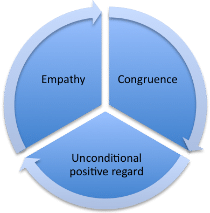Human beings are at the heart of every therapy. Each human is different, with his own potential and character. Therefore, an individual approach is not only preferable but necessary.

We will develop the therapeutic process together, on a level playing field. My task as a therapist is to accompany you as you work on your issues in a responsible and empathetic manner. My therapy is anchored in Carl Rogers’ humanist tradition. People’s psychological crises are seen as chances for them to take themselves seriously, to find their own way to live.
My methods include client-centred conversations and music and hypno therapy interventions, as well as the mirroring of people’s inner mental worlds and ego states through representative perception. I find Prof. Ruppert’s psycho-traumatology theories particularly useful as well the depth psychology of Carl Jung’s student Erich Neumann.
“Painting, art, music and movement enable access to experiences from the baby stage, a time in which there was no access to words for processing.” (Prof. Karl-Heinz Brisch)
Early bonding experiences have a very significant effect on our psyche. When they are traumatic, i.e. perceived subjectively as being life-threatening, we develop survival mechanisms that can remain with us our whole lives and have a long-lasting impact on our unconscious and barely controllable reaction patterns. Because in our early childhood, we are completely dependent on the person with whom we bond, there can be major consequences if the attachment relationship is damaged. This is particularly true during the phase in which the brain is still developing. In the early pre-natal phase, a child is still completely connected to his mother. His perception of her can have long-lasting effects.
“With every successful step, new forces are unleashed for the next one.” (Prof. Franz Ruppert)
This is where the therapy that I practise sets off from. It is bonding-based, systemic and creative. To begin with, we work with our healthy resources and strengthen them. Then we become conscious of the different facets of our ego, our different ego-states. Next, we start to understand which ego-states are dominated by our survival strategies. A further step consists of recognising our fears and defence mechanisms to avoid any pain we might have experienced. Then we cautiously learn to allow feelings to return.
“Integration results in being able to put yourself first in a clear and honest way… It is a process of discovering who you really are, of finding the truth of yourself…” (Vivian Broughton)
The goal of the therapy is to become whole again, to bring feelings and thoughts into harmony with each other: It is a path of constant self-recognition. If you want to discover yourself and dream of living a life that reflects the way you really are, then you’ve come to the right place. That’s why I also describe my practice as one practice for identity-oriented psychotherapy.
“When I no longer had a foothold and fell, I fell here, at my own feet. With the friendly support of my fellow travellers, I was able to hold the fearful child within me, to fall with him and become somewhat more adult.” (Dr. Albrecht Mahr)
Sometimes during the course of therapy we might touch on points that have to do with the traumas of our parents, grandparents or even ancestors further back. Regardless of whether our ancestors were perpetrators or victims or involved in perpetrator-victim dynamics, or whether we are dealing with collective or individual events, the consequences of these often reach into the present. In such cases, it can be rewarding and liberating to become conscious of this. We can also work with this trans-generational approach.